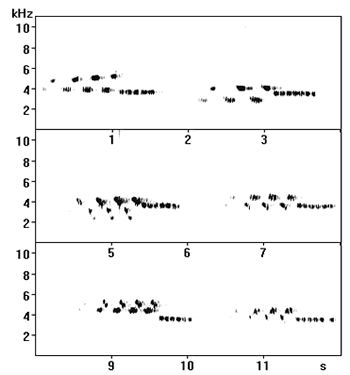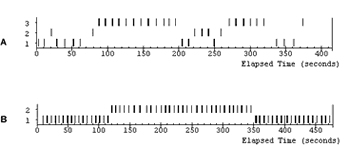
Repertoire size, song types and temporal pattern of song switching in a population of Ortolan Bunting from western Poland
T.S. Osiejuk
Department of Animal Morphology, Institute of Environmental Biology, Adam Mickiewicz University, Poznan, Poland
I analyzed song diversity and variability of the Ortolan Bunting Emberiza hortulana to help assess the function of multiple song types and switching between them during bouts. Because of their focus on song categories and repertoire size, earlier studies did not analyze temporal aspects of within-bout song variability, which must be known in order to plan more advanced experiments, e.g. with interactive playback. Therefore, in this study I concentrated also on the characteristic of song types production within song bouts.
The study was conducted near Poznan (western Poland), where Ortolan Bunting is still a common species in its typical habitats. Over 150 males were recorded in the springs of 1997-1999 with a Sony TCD-D8 DAT recorder and Sennheiser ME67 shotgun microphone. Spectrograms were computed with Avisoft-SASLab Pro 3.75 and temporal analyses were done using The Observer 3.0 (Noldus Information Technology).
Songs were typically two-part: an introductory phrase of 2 to 6, usually double-element syllables, followed by a terminal phrase, composed of a few short and identical elements forming highly amplitude-modulated whistle (Figure 1). Individual repertoire sizes varied between 1 and 5 song types, however over 80% of males sang exactly 2 song types. There were on an average 1.3 different song types per recorded male within the studied population. Consequently, many song types were shared by several males. Each song type was uttered by 6 to 25% of all recorded males. There was a high degree of stereotypy of song both within individuals and type. Infrequently, songs were shortened by deleting one or few initial syllables or the whole final phrase. Therefore, the variation in song length (min-max: 0.51-1.48 s, mean±SD: 1.48±0.20) resulted mainly from the differences between song types. Lengths of the following song renditions for a given male and type were almost equal (CV < 3%), which proves the high level of stereotypy. Between-song intervals varied between 0.60 and 21.85 s (7.1±2.77). Individuals usally sang less than 10 minutes without changing the place of singing. However, bout duration in this species might be easily shortened by the observer behaviour.

Figure 1. Typical song phrases of Ortolan Bunting Wielkopolska region (W. Poland).
Singing rate varied between 4 and 15.6 songs per minute (7.87±2.44). Series of one song types within a bout were very variable 1-31 (7.9±6.5), however rarely (<10%) exceded 15 songs. Song bouts can be divided into two classes: (i) with short series (3±2.6), and consequently, frequent switches - Figure 2A; (ii) with longer series (8.6±5.7) and less frequent switches - Fig 2B. Such different ways of using repertoires were not connected with an individual male's or recording's features (e.g. length), but with the context of singing (counteringing, male status etc.).

Figure 2. Two categories of Ortolan Bunting song bouts: (A) - with short series of one song type, and frequent switches, and (B) - with long series and relatively rare switches. Each bar represents a song phrase; numbers on X-axis indicate different song types.
This study was funded by Polish Science Committee (KBN 6/PO4C/038/17).
Poster presented at Measuring Behavior 2000, 3rd International Conference on Methods and Techniques in Behavioral Research, 15-18 August 2000, Nijmegen, The Netherlands